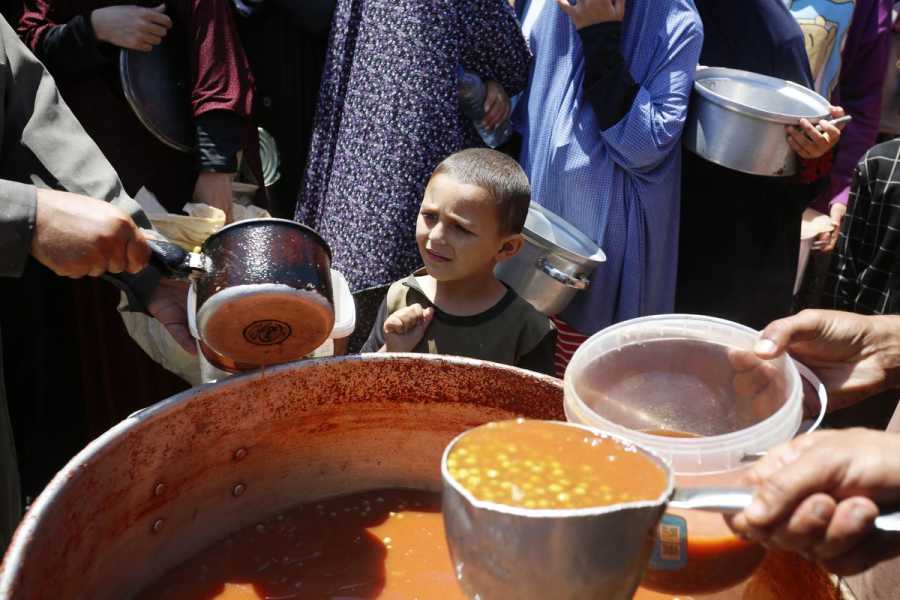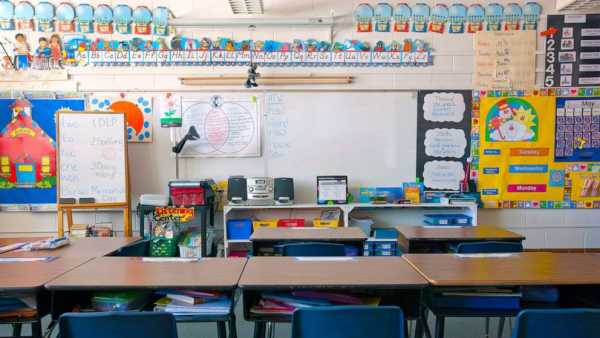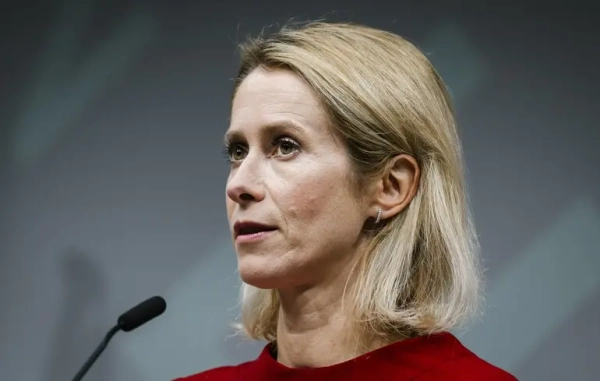And why it’s not nearly enough.

Palestinians displaced from Rafah due to Israeli attacks wait in long queues to get a bowl of food distributed by charity organizations in Deir al-Balah, Gaza, on May 13, 2024. Ashraf Amra/Anadolu via Getty Images Ellen Ioanes covers breaking and general assignment news as the weekend reporter at Vox. She previously worked at Business Insider covering the military and global conflicts.
The US Department of Defense has completed a temporary pier off the Mediterranean coast of Gaza to deliver urgently needed aid — an important goal, but really only a $320 million bandage on the humanitarian crisis 2.3 million people are currently facing.
The US military announced that on Thursday at 7:40 am Gaza time the pier had been attached to land; trucks began moving supplies Friday. The World Food Program is coordinating aid delivery.
The purpose of the pier is to facilitate the flow of humanitarian aid into Gaza, which has been erratic and insufficient for the past seven months following Israel’s initial siege on the territory after Hamas’s attack in October. Both Israel and Egypt have closed border crossings at times over the past seven months, and aid groups accuse Israel of restricting the food, clean water, fuel, and medical aid that passes through even when the borders are technically open.
More than 35,000 people have been killed so far in the war already, primarily due to Israeli bombing campaigns.
People in all parts of the region, especially the north, are facing acute levels of hunger. That’s obviously a crisis in and of itself; it also makes people more vulnerable to dying from communicable diseases, particularly because the Israeli campaign has decimated Gaza’s health care system. Clean water is nearly inaccessible; people in Gaza are living on less than 2 liters a day, according to UN estimates, well short of the 7.5 to 15 liters people need each day for basic consumption and sanitation in emergency situations and 70 liters under normal situations.
The pier is expected to deliver primarily food aid, but also treatment for malnutrition, like high-nutrient food bars and other therapeutic foods for acute cases, according to USAID. US officials have also emphasized the need to get clean water and fuel into Gaza, but have not yet provided specifics regarding how and how much of those commodities will enter through the maritime corridor.
To be clear, there are better, more efficient ways to get aid into Gaza, experts say. The US can use its leverage — access to weapons — with Israel to increase aid via land routes. It could push for a ceasefire agreement that would allow humanitarian organizations to deliver aid in exchange for Hamas releasing hostages it took during its October 7 attack on Israel.
The fact that the US has to resort to building a pier to get aid into Gaza underscores how fraught the US-Israeli relationship has become — and how the Biden administration seems unable or unwilling to make any broader changes in its policy toward Israel.
How will the pier work?
Biden first announced the plans for the maritime corridor in his State of the Union address on March 7, emphasizing the immense need for humanitarian aid in Gaza. Government officials have repeatedly stressed that the pier is meant to be a temporary addition to overland aid flows through border crossings, and that US troops won’t be entering Gaza.
Aid is supposed to come via ship from Cyprus to the new port’s staging area, where the cargo will be inspected by the Israeli military and then handed over to the World Food Program and international NGOs for distribution. The US, the United Arab Emirates, the UK, France, the European Union, Cyprus, and the United Nations are all contributing either logistical support or humanitarian assistance.
The route to get there, though, is immensely complicated.
As of Thursday, ”We have about 500 tons of humanitarian assistance loaded on ships,” Vice Admiral Brad Cooper said in a news briefing. “That’s about a million pounds ready for delivery in the coming days,” with thousands of tons of aid “in the pipeline.” The Department of Defense says it anticipates about 90 truckloads per day of aid to get into Gaza through the maritime corridor, ramping quickly up to 150 trucks per day.
Why is the pier needed?
One of Israel’s first steps following the October 7 attacks was to launch an all-out siege on Gaza. Defense Minister Yoav Gallant instituted that policy on October 9, saying: “There will be no electricity, no food, no fuel. Everything is closed.”
Siege warfare is against international law, and Israel was eventually forced to let in aid, albeit only via the Rafah crossing that Gaza shares with Egypt. That crossing opened to allow aid through in late October but still only allowed in a fraction of the aid Gaza’s population of 2.3 million people had prior to the war. Israel opened the Kerem Shalom crossing, also in southern Gaza, in December, but there have been periodic blocks to aid delivery, right-wing Israeli protests blocking entry to the crossing as well as a closing early in May because of an attack by Palestinian fighters near the crossing killed four Israeli soldiers.
Gaza has been under blockade by Israel to some degree since Hamas took over the region in 2007. Hamas as the governing body has no control over Gaza’s borders, limiting the territory’s ability to trade and leaving Gaza heavily dependent on outside aid.
Though the area is very densely populated and highly urbanized, domestic agriculture was a significant part of the economy prior to the current war; about 44 percent of household food came from Gaza-based production, according to a January report from the International Food Policy Research Institute.
By January, a third of all the agricultural land in Gaza had been rendered unusable, according to the report, and war and displacement had essentially halted the agriculture industry. The outside aid that is still getting in is not nearly enough for people to survive on, experts say.
“One-fourth of calories needed is what’s getting in,” Tak Igusa, a contributor to a joint Johns Hopkins and London School of Hygiene and Tropical Medicine report on death projections in Gaza due to the war, told Vox in March. “So just imagine having one-fourth of what you usually eat for such a long duration. And it’s getting worse.”
There was a temporary increase in aid following international backlash to the Israeli killing of seven aid workers from World Central Kitchen, an NGO that had delivered 43 million meals to Palestinians in Gaza prior to the incident. But the increased aid has not been sustained, especially since Israel began operations in Rafah earlier this month, interrupting the flow of goods through the border crossing there, which Egypt has now closed.
Will this fix the crisis?
In short, no. The scale of this preventable crisis is just too big for this one effort alone to solve.
Other solutions are quite clear: keeping the land border crossings open, pushing the Israeli government to allow sufficient aid in, and prioritizing deconfliction processes so humanitarian workers can safely do their jobs. Overland mechanisms like trucks can move faster, and more than 2,000 trucks filled with supplies are already on the Egyptian side of the Rafah border crossing, according to Jesse Marks, senior advocate for the Middle East at Refugees International, unable to get their cargo to people that need it.
There is also concern about the safety of the people involved in the aid operation, given the fact that more than 250 aid workers have been killed over the course of the war. Just this week, an aid worker was killed by Israeli fire while working for the UN in Rafah. The person was riding in a clearly marked UN car.
USAID and the World Food Program will oversee aid distribution in coordination with other NGOs. USAID Response Director Dan Dieckhaus told reporters in a briefing Thursday that “deconfliction” processes — coordination with the Israeli military so that aid workers can perform their jobs — is a serious concern. “We’re not at all satisfied with where they’re at now,” Dieckhaus said of discussions with the Israeli government around those processes.
Hamas could also see Israeli military presence at the port as a threat, opening the risk of attack.
Ceasefire talks — ongoing in Cairo when Israel launched the Rafah operation — also seem to be stagnant.
“The administration is pushing for more attention to civilian casualties, more humanitarian aid, and a sooner end to widespread military operations,” Jennifer Kavanagh, senior fellow in the American Statecraft Program at the Carnegie Endowment for International Peace, told Vox. “On the other hand, they’re continuing to send, maybe not the biggest bombs, but plenty of offensive weapons for Israel to continue to carry out an offensive campaign.”
Sourse: vox.com






